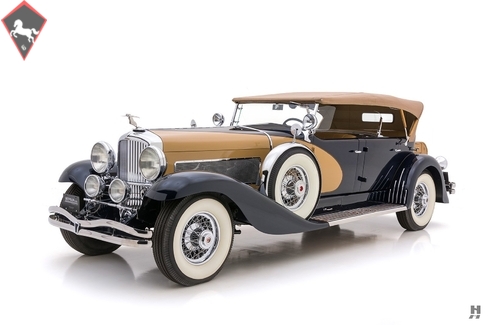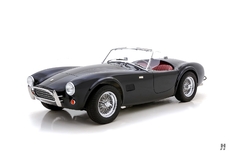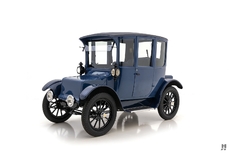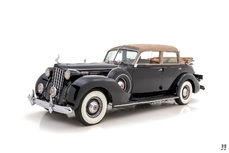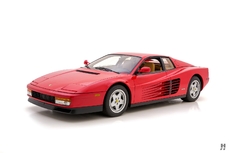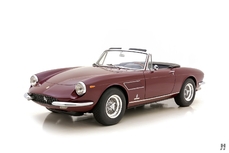Duesenberg J 1935
General description :
Within moments of its unveiling at the New York Auto Show on December 1, 1928, the world’s business moguls, movie stars, and social elite lined up for their chance to own the glamorous new Duesenberg Model J. At its heart lay a 420-cubic inch, Lycoming-built inline eight-cylinder engine featuring twin overhead camshafts and four valves per cylinder, rated at 265 horsepower in naturally aspirated form. The robust chassis was beautifully engineered, with powerful hydraulic drum brakes and fully automatic chassis lubricating that operated every 30-60 miles. The Model J vanquished everything else on the road and was by far the fastest, most exclusive, and most expensive car in America. At nearly $10,000 for a chassis alone, sales never quite lived up to E.L. Cord’s hopes of 500 vehicles per year, and sales topped off at just 481 cars in total. Today, the Model J and its derivatives stand as the Gold Standard of Classic Era automobiles and hold a place of pride among the most iconic and desirable motorcars ever produced in America.
THE PRESIDENT’S COMPANY CAR
During the height of the coachbuilding era from the 1910s through the late 1930s, it was not uncommon for wealthy owners to have a favorite coachbuilt body they would recondition and move between new chassis every few years. This practice saved the considerable expense of building a new body each time, which in some instances could exceed the cost of a chassis.
Lucius B. Manning was no exception to this practice, and as President of Duesenberg Motors, had at his disposal a “sweep panel” dual-cowl phaeton, penned by the great Gordon Buehrig and constructed under the LaGrande label by Union City Body Company. Buehrig’s take on the shape was considerably cleaner than earlier LeBaron versions of this design, especially when paired with the long-wheelbase chassis, as Mr. Manning’s body was.
Mr. Manning used that phaeton body on no fewer than four different Model J Duesenberg chassis, of which this car, chassis number 2592 with engine number J-562, was one. For about a year, it was driven by Mr. Manning in Chicago, where Cord Corporation had its base of operations. When an order for a “new” Duesenberg chassis came through, Manning allowed his chassis to be taken for the sale (he had before and would again), and it was re-bodied as a Willoughby Berline for delivery to a lucky owner.
The Willoughby body on 2592/J-562 was removed years later, and A.T. O’Neill sold the chassis to the well-known collector Hubert Fischer of Minnesota. Mr. Fischer was a passionate Duesenberg enthusiast who owned several Model Js during his long involvement in the hobby. Well aware of the car’s significance, he had Mr. Manning’s original LaGrande Dual-Cowl Phaeton body recreated by respected craftsman Harold Orchard of California, whose work was extremely highly regarded. It is important to note that the curvaceous skirted fenders, which are of the type added to many later Duesenbergs, are correct, as Mr. Manning’s original LaGrande body was so-modified during his tenure.
The car remained with the Fischer family for many years, during which time it was regularly shown at various Midwestern concours d’elegance. It was eventually acquired from them by the well-known enthusiast Gerry Shaw of Connecticut and Florida, who commissioned a cosmetic restoration, finished to a very high standard. The car was entrusted to well-known Duesenberg technician Brian Joseph’s Classic & Exotic Service, in Troy, Michigan, for an engine rebuild and installation of one of their highly regarded reproduction superchargers, upgrading the engine to ultimate “SJ” specifications.
Stunningly presented in cobalt blue with khaki sweep panels, the Duesenberg features biscuit tan leather coordinated with blue carpets, all of which is in superb condition, as is the tan cloth top and upholstered, correct trunk. Gorgeous period-correct fitments and accessories include six chrome wire wheels shod in wide whitewall tires, polished side-mount spare wheel covers, dual tail lamps, dual spotlights, and dual Pilot Ray driving lights. This striking Duesenberg was presented at the Greenwich Concours d’Elegance in 2014 and awarded Best of Show, a testament to the elegant and classic lines of its beautiful design as well as its magnificent restoration.
Years of exhaustive work have been poured into this Model J to make it just as it was when Duesenberg’s top man enjoyed it on a daily basis, and this striking machine would be no less enjoyable to drive and show today. It has made very few concours or show appearances since its star turn at Greenwich and would surely be a welcome sight in Auburn Cord Duesenberg Club, AACA, or CCCA circles, and would be most at home blasting along with fellow enthusiasts on the Duesenberg Tour.
Offers welcome and trades considered
https://hymanltd.com/vehicles/6946
1935 Duesenberg J is listed sold on ClassicDigest in St. Louis by Mark Hyman for $1250000.
Car Facts
Car type : Car Make : Duesenberg Model : J Engine size : 0.0 Model Year : 1935 Sub type : Convertible Location : Missouri
Sold
Seller Information
Sold
Other cars listed for sale by this dealer
About Duesenberg
The Duesenberg automobiles, often referred to as "Duesies," were indeed some of the finest and most prestigious luxury cars of the 1920s and 1930s. They were produced by the Duesenberg Automobile and Motors Company, Inc., which was based in the United States. The most famous Duesenberg models from this era were the Duesenberg Model J and its supercharged variant, the Duesenberg Model SJ.Duesenberg cars were known for their exceptional craftsmanship, powerful engines, and advanced engineering. They were often custom-built to the exact specifications of their wealthy clientele, including many celebrities and royalty. The Model J, in particular, featured an inline-eight engine that was not only powerful but also highly refined for its time.
One of the standout features of the Duesenberg Model J was its supercharged SJ version, which could reach incredibly high speeds, making it one of the fastest cars of its time. These cars were known for their elegance and performance, and they remain highly sought after by collectors and enthusiasts today.
The Duesenberg brand is synonymous with luxury and quality from the interwar period, and these automobiles are considered iconic examples of American automotive engineering and design during the 1920s and 1930s.
It's subjective to say whether Duesenberg cars are better than Rolls-Royce cars, as both brands have their own unique qualities and cater to different aspects of the luxury automobile market. Preferences between the two brands often come down to individual tastes and priorities. Here are a few factors to consider when comparing Duesenberg to Rolls-Royce:
Historical Significance: Duesenberg was known for its luxurious and high-performance cars in the 1920s and 1930s, while Rolls-Royce has a long history of producing luxury cars dating back to the early 20th century. Rolls-Royce has maintained its reputation for craftsmanship and excellence for a much longer period.
Customization: Both Duesenberg and Rolls-Royce offered high levels of customization, but Rolls-Royce is renowned for its bespoke options. Rolls-Royce cars are often considered the epitome of personalized luxury, with virtually limitless customization choices.
Engineering and Innovation: Rolls-Royce has been at the forefront of technological innovation in the luxury car industry for many years. They are known for their quiet, smooth rides and advanced engineering, including the use of modern materials and cutting-edge technology.
Modern Production: Rolls-Royce continues to produce luxury automobiles today, while Duesenberg ceased production in the mid-20th century. Rolls-Royce has adapted to modern automotive standards, while Duesenberg cars are vintage classics that are no longer in production.
Rarity and Collectibility: Duesenberg cars are highly collectible due to their limited production and historical significance. They often command high prices at auctions. Rolls-Royce cars are also collectible, but they are more common on the market, given their continuous production over the years.
In summary, whether Duesenberg is better than Rolls-Royce is a matter of personal preference and priorities. Rolls-Royce is known for its long-standing reputation, technological advancements, and bespoke luxury, while Duesenberg, while historically significant and prestigious, is no longer in production and represents a different era of luxury automotive craftsmanship. Both brands have their own distinct charm and appeal to different segments of the luxury car market.
